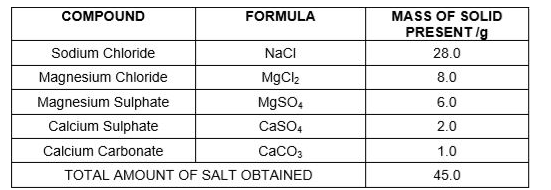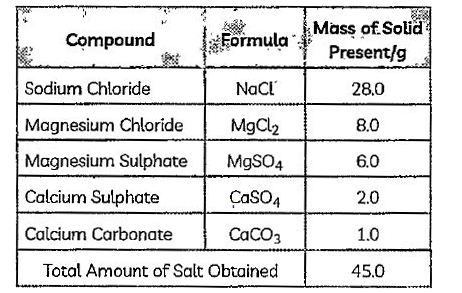How many bands are seen when immunoglobulin G molecules are analysed on a sodium dodecyl sulphate polyacrylamide gel electrophoresis (SDS-PAGE) under reducing conditions ?
6
1
2
4
The correct Answer is:C
On SDS-PAGE of IgG two principal Bands are visible
Similar Questions
The Salt Story
From: The New Indian Express 9 March 2021
The salt pans in Marakkanam, a port town about 120 km from Chennai are the third largest producer of salt in Tamil Nadu. Separation of salt from water is a laborious process and the salt obtained is used as raw materials for manufacture of various sodium compounds.
One such compound is Sodium hydrogen carbonate, used in baking, as an antacid and in soda acid fire extinguishers.
The table shows the mass of various compounds obtained when 1litre of sea water is evaporated

How many grams of Magnesium Sulphate are present in 135g of solid left by evaporation of sea water?
View SolutionMany lyophilic sols and few lyophobic sols when coagulated under some special conditions changes into semi rigid mass, enclosing whole amount of liquid within of liquid within itself, it is called gel and the process is called gelation. Gelatin, agar-agar, gum-Arabic can be converted into gels by cooling them under moderate concentration conditions. Hydrophobic sols like silicic acid. Al(OH)3 are prepared by double decomposition and exchanged of solvent method.
Types of gel :
1. Syneresis/weeping of gel : The spontaneous liberation of liquid from a gel is called syneresis or weeping of gels. It is reverse of swelling.
e.g., geletin, agar-agar show syneresis at low concentration while silicic shows it at high concentration.
2. Imbibition or swelling of gel : When gel is kept in a suitable liquid (water) it absorb large volume of liquid. The phenomenon is called imbibition or sweeling of gel.
3. Thixotropic : Some gels when shaken to form a sol, on keeping changes into gel are termed as thixotropic gel and phenomenon is called thixotropy.
e.g., gelatin and silica liquify on shaking changing into corresponding sol and the sol on keeping changes back into gel.
Some types of gels like gelatin and silica liquify on shaking thereby changing into sols. The sols on standing change back into gels. This process is know as :
View Solution
Knowledge Check
Which one of the following combination of molecular masses of polypeptides are obtained from purified human IgM when analysed on sodium dedecyl sulphate polyacrylamide gel electrophoresis (SDS-PAGE) under reducing conditions
A55kDa,15kDaB70kDa,25 kDa, 15 kDaC55 kDa,25 kDaD155kDaPyrolusite, MnO2, is the main ore from which manganese is produced. The manganese content of the ore may be determined by reducing the MnO2 under acetic conditions to Mn2+ with the oxalate ion, C2O2−4, the oxalate ion being oxidised to carbon dioxide during the reaction. The analytical determination is carried out by adding a known excess volume of oxalate solution to a suspension of the pyrolusite and digesting the mixture on a hot water bath until all the MnO2 has been reduced. The excess, unreacted oxalate solution is then titrated with standardised potassium permanganate, KMnO4 solution after which the manganese content of the ore can be calculated.
A student prepared a standard solution of sodium oxalate by weighing 3.2 g of the dry anhydrous salt, dissolving it in distilled water and making the solution up to 500 mL. 25 mL of the oxalate solution required 24.76 mL of KMnO4 solution.
How many moles of C2O2−4 ions will be oxidised by 1 mole MnO−4 ?A1/2B3/2C5/2D7/2Many lyophilic sols and few lyophobic sols when coagulated under some special conditions changes into semi rigid mass, enclosing whole amount of liquid within of liquid within itself, it is called gel and the process is called gelation. Gelatin, agar-agar, gum-Arabic can be converted into gels by cooling them under moderate concentration conditions. Hydrophobic sols like silicic acid. Al(OH)3 are prepared by double decomposition and exchanged of solvent method.
Types of gel :
1. Syneresis/weeping of gel : The spontaneous liberation of liquid from a gel is called syneresis or weeping of gels. It is reverse of swelling.
e.g., geletin, agar-agar show syneresis at low concentration while silicic shows it at high concentration.
2. Imbibition or swelling of gel : When gel is kept in a suitable liquid (water) it absorb large volume of liquid. The phenomenon is called imbibition or sweeling of gel.
3. Thixotropic : Some gels when shaken to form a sol, on keeping changes into gel are termed as thixotropic gel and phenomenon is called thixotropy.
e.g., gelatin and silica liquify on shaking changing into corresponding sol and the sol on keeping changes back into gel.
The process of imbibing water when elastic gel are placed in water is called :AimbibationBsynerisisCcoagulationDthixotropy
Many lyophilic sols and few lyophobic sols when coagulated under some special conditions changes into semi rigid mass, enclosing whole amount of liquid within of liquid within itself, it is called gel and the process is called gelation. Gelatin, agar-agar, gum-Arabic can be converted into gels by cooling them under moderate concentration conditions. Hydrophobic sols like silicic acid. Al(OH)3 are prepared by double decomposition and exchanged of solvent method.
Types of gel :
1. Syneresis/weeping of gel : The spontaneous liberation of liquid from a gel is called syneresis or weeping of gels. It is reverse of swelling.
e.g., geletin, agar-agar show syneresis at low concentration while silicic shows it at high concentration.
2. Imbibition or swelling of gel : When gel is kept in a suitable liquid (water) it absorb large volume of liquid. The phenomenon is called imbibition or sweeling of gel.
3. Thixotropic : Some gels when shaken to form a sol, on keeping changes into gel are termed as thixotropic gel and phenomenon is called thixotropy.
e.g., gelatin and silica liquify on shaking changing into corresponding sol and the sol on keeping changes back into gel.
Which of the following is used to adsorb water?
View SolutionCase : The Salt Story
From: The New Indian Express 9 March, 2021
The salt pans in Marakkanam, a port town about 120 km from Chennai are the third largest producer of salt in Tamil Nadu. Separation of salt from water is a laborious process and the salt obtained is used as raw materials for manufacture of various sodium compounds.
One such compound is Sodium hydrogen carbonate, used in baking, as an antacid and in soda acid fire extinguishers.
The table shows the mass of various compounds obtained when 1 litre of sea water is evaporated

How many grams of Magnesium Sulphate are present in 135 g of solid left by evaporation of sea water ?
View SolutionDirect titration of I2 with a reducing agent is called iodimetry. If I2 is leberated by the oxidation of Iɵ ion by a strong oxidising agent in neutral or acidic medium, the liberated I2 is then titrated with reducing agent. Iodometry is used to estimate the strngth of the oxidising agent. For example, in the estimation of Cu2+ with S2O2−3
Cu2++Iɵ→CuI2+I2 (iodometry)
I2+S2O2−3→S4O2−6+Iɵ (iodimetry)
Strach is used as an indicator at the end point, which forms bluecoloured complex with Iɵ3 Disappearance of blue colourindicates the end point whe free I2 in not present.
Q. In the reaction
2CuSO4+4KI→Cu2I2+2K2SO4+I2
The equivalent weight of CuSO4 is
(Mw=159.5gmol−1)
View Solution
